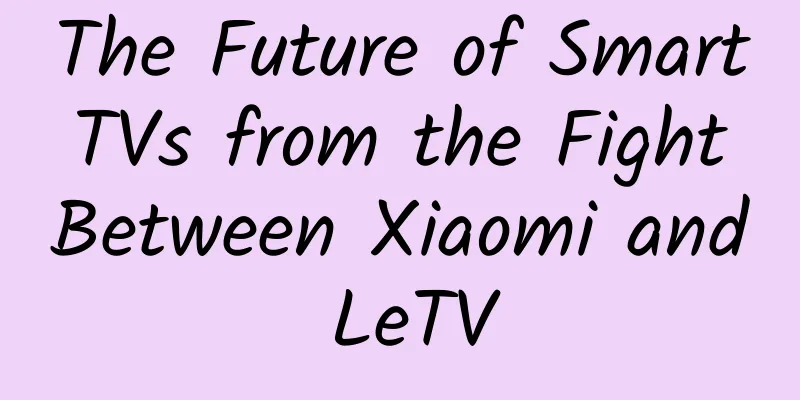The Future of Smart TVs from the Fight Between Xiaomi and LeTV

|
The war between Xiaomi and LeTV has been going on for a whole week. Usually, after such a long time, there is no winner or loser. The spectators are not so enthusiastic anymore. Instead, some people start to think whether the fight is true or false. Although the topic is updated, it does not touch any pain points. Instead, it has earned headlines in all major pages. The reputation has not deteriorated much, and a lot of advertising fees have been saved. However, no matter what conspiracies Xiaomi and LeTV have secretly planned, the smart TV sector has already attracted the attention of many big players. What is the prospect of smart TV, what is the current situation, what problems exist, and what may be the future development direction... We can carefully speculate based on the war of words between Xiaomi and LeTV and Hisense's so-called good-intentioned mediation. What has changed with smart TV? The impact of the Internet on traditional industries has been rapid and severe. In just a few years, smart TVs have quickly occupied the home market and have begun to take shape. Although the popularity of smart TVs is not enough to drive traditional TVs out of the market due to concepts, habits, price, technology and other limitations, but judging from the current trend, it seems to be only a matter of time. Why do you say that? Let's first look at Xiaomi's slogan for smart TVs: "Be the first TV for young people." Behind this slogan is: assume that young people don't have a TV. This is a typical behavior of creating an incremental market: let people who don't have a TV directly own an Internet TV. As we all know, the main users of TVs are the elderly and children, while the user positioning of smart TVs is young people. Imagine that if smart TVs are supported by young people, the market for the elderly and children will be greatly reduced, while the market for young people will be opened up, and the future of smart TVs will be immeasurable. While smart TVs are constantly expanding the market, they are also changing the way the TV industry competes. Traditional color TVs don't need to worry too much about content, because the State Administration of Radio, Film, and Television is in charge. As long as the character is not too bad, there is almost no competitive pressure. Smart TVs are different. Their shortcomings are hardware and users, and their advantage is self-made content. Since they don't have to follow the rules of the State Administration of Radio, Film, and Television, LeTV and Xiaomi, which got the Internet copyright of low-priced film and television program content, did make traditional TV manufacturers jealous in the early days of making smart TVs. It's a pity that the good times didn't last long. I don't know whether traditional TV manufacturers filed a complaint or the State Administration of Radio, Film, and Television realized that the policy was being exploited. In short, Xiaomi was put on the emergency brake by the policy on the road of trying to aggregate. As a result, the content war between Xiaomi and LeTV focused on "quantity and price" again. The difference between traditional thinking and Internet thinking began to emerge at this time. Victory requires speed. Due to the delay in the time of Hisense's release of the "Ju Haokan" platform, Xiaomi seized the initiative in the legal aggregation routine. At the same time, LeTV saw that the capital investment in self-made content could increase differentiated competition. As a result, excellent self-made content such as "Yellow Jokes" gushed out, and Hisense was crushed again. At the same time, we have always emphasized that technology changes our lives. The biggest change that smart TVs bring to our lives is convenience and speed. They allow seamless connection between TV and the Internet, greatly increasing the content capacity of TV. At the same time, the large screen, high definition and ultra-thinness give you better audio-visual enjoyment and user experience, greatly improving the happiness of home life. What is restricting the development of smart TVs? Although the idea of smart TV is good and has broad prospects, according to public data, the sales volume of LeTV smart TV is 1.5 million units and the sales volume of Xiaomi TV is 300,000 units. This number is not optimistic. What is restricting the development of smart TV? First, in China, the users who watch TV the longest happen to be the ones with the lowest Internet acceptance. Traditional concepts are the first challenge facing smart TVs. Of course, this challenge is not big, but with the development of mobile Internet, this will not be a problem. However, the change of concepts also requires technological follow-up. The current situation is that in the human-computer interaction design of smart TVs, the remote control cannot allow users to switch repeatedly between multiple different apps as conveniently as touch or mouse, which greatly increases the time it takes for users to discover content. Internet users are generally lazy, so this problem will also restrict the growth of purchases. Whether a product is popular or not, quality and price are also major factors. Smart TVs have high requirements for software and hardware. At present, domestic technology is not yet mature, and hardware prices are difficult to reduce for the time being. At present, in order to expand the market, many businesses are selling below cost. However, due to factors such as short service life and imperfect after-sales service, it is still difficult to gain the favor of users. Traditional color TVs are now a little stronger in technology, but it is obvious that they are still not good at playing with the Internet. For Xiaomi and LeTV, the temporary lead in content has bought them time to improve their design and manufacturing capabilities. This is also their best opportunity to catch up with traditional manufacturers in overall capabilities. Third, smart TVs also have their own shortcomings. Mobile phones and computers can be online 24 hours a day and are closer to the human body, but it is difficult for TVs to do this. If TV is used as a supplement to the multi-screen era, then you need to fully connect the TV, computer and mobile phone ecosystems, which is far from enough at present. Even if some users buy it, it is mostly because of the deception of TV manufacturers and sales staff. They don’t know how to use it, and even the product is not activated. For merchants, there is no more value space to expand. How can we break through the profit model of smart TVs? Since we have targeted Xiaomi, LeTV and Hisense, let’s take these three companies as examples. LeEco and Xiaomi both realize that the current market must quickly complete the transformation of profit models from relying on hardware prices to relying on content management and user experience, and LeEco has proven through practice that hardware is not a profit point for earning profits. The reason why the two companies' quarrel is insignificant is that in terms of content, the two companies have completely different development directions. LeTV focuses on high-quality video content and IP (intellectual property), trying to embed content into all terminals (smart TVs, TV boxes, smart phones, smart cars). Therefore, LeTV is more interested in getting all the high-quality video content and expanding into the hardware field based on the advantages of content. Xiaomi's core is always the mobile phone, and smart TV is just a radiation point of the mobile phone. Xiaomi wants to use the router as the most important bridge between the mobile phone and the TV. The reason why it spent 1 billion US dollars to attack the video market is just to show its determination to attack the smart TV market and the importance it attaches to content. Xiaomi is not interested in self-made content. Building a complete ecosystem of hardware, software, content and service partners with content as the core is the main development method and profit model of Internet companies in the field of smart TVs. If this chain can be done well, the subsequent content, applications, sales of related products and advertising push will generate huge profit margins. This is the key reason why Xiaomi and LeTV are willing to spend so much money now! Hisense is different from Xiaomi and LeTV, mainly because it is the leader in traditional TVs. It has two inherent advantages in entering the smart TV market: a large user base and rich experience. A truth that most product managers understand is that sometimes, the sales channel is more important than the product itself. Hisense has been making TVs for many years, and its reputation has long been known. No one knows what users want better than him. In front of him, Xiaomi and LeTV can only be regarded as children. On the morning of June 15, Hisense held an offline press conference with the theme of "All Living Things", announcing that Hisense smart TVs have activated more than 10 million terminals. Compared with LeTV's sales of 1.5 million units and Xiaomi's sales of 300,000 units, Hisense's total sales of smart TVs are 13.8 million, and the activation rate is 77%. This will take Xiaomi and LeTV several years to catch up, so Hisense's smart TV ecosystem has obtained 10 million yuan advertising cooperation contracts signed by Jiaduobao and Mengniu respectively, while Xiaomi and LeTV can only sigh in despair. As one of the first advertisers to place video ads on the Haishi Cloud platform, this means that advertisers recognize the advertising effect of large-screen TVs, and further demonstrate Hisense's strength in the smart TV market. Of course, Hisense also has its shortcomings. After all, it was once a traditional enterprise and its Internet thinking was not so active. Although it has obtained the fat piece of advertising, it seems that there is no clear direction on how to generate commercial value from the user data accumulated over the years. The connection between related products and applications and TV is also very unfamiliar. It is still unknown how long it can maintain the closed loop of "content terminal data service" to produce value. Last words: What is mentioned above are just some thoughts triggered by the quarrel between Mile and Xiaomi. At present, due to the limitation of various factors such as network speed, the profit model mentioned above has not achieved very good results. However, the video industry is developing rapidly, 3D and 4D are emerging, and streaming media technology is becoming more and more mature. Therefore, it can be predicted that once the market share of smart TVs reaches a certain level, innovation will immediately sweep in. As a winner of Toutiao's Qingyun Plan and Baijiahao's Bai+ Plan, the 2019 Baidu Digital Author of the Year, the Baijiahao's Most Popular Author in the Technology Field, the 2019 Sogou Technology and Culture Author, and the 2021 Baijiahao Quarterly Influential Creator, he has won many awards, including the 2013 Sohu Best Industry Media Person, the 2015 China New Media Entrepreneurship Competition Beijing Third Place, the 2015 Guangmang Experience Award, the 2015 China New Media Entrepreneurship Competition Finals Third Place, and the 2018 Baidu Dynamic Annual Powerful Celebrity. |
<<: With wolves in front and tigers behind, is there still hope for Sony mobile phones?
>>: What should “friendly competitors” in the war of words learn from Uber?
Recommend
Qualcomm counter-sues Apple: iPhone would not be successful without Qualcomm's technology
Qualcomm today filed a response and counterclaim ...
During the epidemic period, how can the retail industry use [community operation] to break through?
I hope that today’s summary can bring a little in...
Mobile game channel cooperation model ushered in innovation, "joint operation + delivery" became the new standard
The game market has never stopped debating whethe...
Li Jiaoshou·Top Copywriter's 5th Anniversary Sharing Speech
The theme of this speech is: X-type copywriting a...
How does the South-to-North Water Diversion Project achieve the goal of “water flowing to higher places”?
The terrain of the East Route Project of South-to...
How to use Tik Tok more efficiently? Master these five vertical screen thinking!
Why is it that when Chengdu sweet girl says “I th...
Cow "matrix": giving cows a virtual grassland, away from the pain of crowded farms
Although the fourth installment of The Matrix suf...
Keep warm together? Blood routine test found "jelly blood", it turns out that red blood cells are also "afraid of cold"
After the Spring Festival, the cold wind blew in ...
E-commerce operation: a comprehensive review of promotional activities skills!
In this article, let’s take a look at the types o...
User Churn Prediction Model, How to Evaluate Its Effectiveness?
The author of this article uses detailed examples...
Introverted personality: Have you “involved” yourself today?
Review expert: Chen Mingxin, national second-leve...
Complete online event operation process!
Online activities must be able to produce short-t...
Practical Tips | 4 steps to create a copywriting title that doubles the readership!
How should the title be written? What psychologic...









